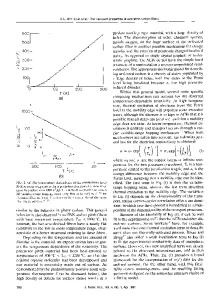Optical Properties of ATO Sol-gel Coated Carbon Fibers
- PDF / 199,884 Bytes
- 6 Pages / 432 x 648 pts Page_size
- 80 Downloads / 371 Views
Optical Properties of ATO Sol-gel Coated Carbon Fibers Brandon Richard1, Norma Alcantar2, Andrew Hoff3, and Sylvia Thomas1 AMBIR Laboratory, University of South Florida, 4202 East Fowler Avenue, Tampa, FL 33620, U.S.A. 2 Department of Chemistry, University of South Florida, 4202 East Fowler Avenue, Tampa, FL 33620, U.S.A. 3 University of South Florida, 4202 East Fowler Avenue, Tampa, FL 33620, U.S.A. 1
ABSTRACT Recent trends in composite research include the development of structural materials with multiple functionalities. In new studies, novel materials are being designed, developed, modified, and implemented into composite designs. Typically, an increase in functionality requires additional material phases within one system. The presence of excessive phases can result in deterioration of individual or overall properties. True multi-functional materials must maintain all properties at or above the minimum operating limit. In this project, samples of Sbdoped SnO2 (ATO) sol-gel solutions are used to coat carbon fibers and are heat treated at a temperature range of 200 – 500 °C. Results from this research are used to model the implementation of sol-gel coatings into carbon fiber reinforced multifunctional composite systems. This research presents a novel thermo-responsive sol-gel/ (dopant) combination and evaluation of the actuating responses due to various heat treatment temperatures. While ATO is a well-known transparent conductive material, the implementation of ATO on carbon fibers for infrared thermal reflectivity has not been examined. These coatings serve as actuators capable of reflecting thermal infrared radiation in mid-range and near-range wavelengths (λ). By altering the ATO sol gel thickness and heat treatment temperatures, optimal optical properties are obtained. While scanning electron microscopy (SEM) is used for imaging, electron diffraction spectroscopy (EDS) is used to verify the compounds present in the coatings. Fourier transform infrared (FT-IR) spectroscopy was performed to analyze the reflectivity in the infrared spectra and analyze the crystal structures after heat treatments. INTRODUCTION In new studies, novel materials are being synthesized and implemented into composite designs to address future application requirements. In doing so, research efforts have been made toward designing materials with multiple properties that can increase the functionality of composites. With the addition of these new materials, degradation of their dominant properties occurs due to the presence of multiple phases. In past research, reflection and absorption of specified wavelengths have been demonstrated by various materials on the micro and nanometer scale [1, 2]. A wide range of applications such as telecommunication system chips [3], window pane sensors for greenhouses [4], and junction layers for solar cells [5] has been developed from these material advancements. In relation to this proposed research, it has been demonstrated that chemically tailored oxides deposited on fiber surfaces can reflect a desir
Data Loading...











